Leedia
On this page, you find all documents, package deals, and flashcards offered by seller leedia.
- 883
- 0
- 4
Community
- Followers
- Following
2 Reviews received
887 items
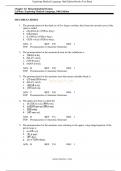
Chapter 14: Musculoskeletal System LaFleur: Exploring Medical Language, 10th Edition
Chapter 14: Musculoskeletal System LaFleur: Exploring Medical Language, 10th Edition MULTIPLE CHOICE 1. The pronunciation for the third set of five larger vertebrae that forms the inward curve of the spine is called a. (tha-RAS-ik) (VER-te-bray). b. c. (LUM-bar) (VER-te-bray). d. (SUR-vi-kal) (VER-te-bray). ANS: C REF: 530 OBJ: 1 TOP: Pronunciation of Anatomic Structures 2. The pronunciation for the anatomical term for the collarbone is a. b. (KLAV-i-kul). c. (STUR-num). d. (MAN-d...
- Exam (elaborations)
- • 22 pages •
Chapter 14: Musculoskeletal System LaFleur: Exploring Medical Language, 10th Edition MULTIPLE CHOICE 1. The pronunciation for the third set of five larger vertebrae that forms the inward curve of the spine is called a. (tha-RAS-ik) (VER-te-bray). b. c. (LUM-bar) (VER-te-bray). d. (SUR-vi-kal) (VER-te-bray). ANS: C REF: 530 OBJ: 1 TOP: Pronunciation of Anatomic Structures 2. The pronunciation for the anatomical term for the collarbone is a. b. (KLAV-i-kul). c. (STUR-num). d. (MAN-d...
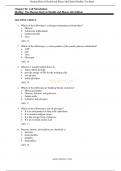
Chapter 04: Cell Metabolism Herlihy: The Human Body in Health and Illness, 6th Edition
Chapter 04: Cell Metabolism Herlihy: The Human Body in Health and Illness, 6th Edition MULTIPLE CHOICE 1. Which of the following is a nitrogen-containing waste product? a. Glucose b. Adenosine triphosphate c. Carbon dioxide d. Urea ANS: D 2. Which of the following is a waste product of the aerobic glucose metabolism? a. ATP b. CO2 c. Urea d. Glycogen ANS: B 3. Glucose is usually broken down to a. make carbon dioxide. b. provide energy (ATP) for the working cells. c. use up urea...
- Exam (elaborations)
- • 11 pages •
Chapter 04: Cell Metabolism Herlihy: The Human Body in Health and Illness, 6th Edition MULTIPLE CHOICE 1. Which of the following is a nitrogen-containing waste product? a. Glucose b. Adenosine triphosphate c. Carbon dioxide d. Urea ANS: D 2. Which of the following is a waste product of the aerobic glucose metabolism? a. ATP b. CO2 c. Urea d. Glycogen ANS: B 3. Glucose is usually broken down to a. make carbon dioxide. b. provide energy (ATP) for the working cells. c. use up urea...
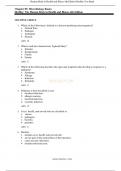
Chapter 05: Microbiology Basics Herlihy: The Human Body in Health and Illness, 6th Edition
Chapter 05: Microbiology Basics Herlihy: The Human Body in Health and Illness, 6th Edition MULTIPLE CHOICE 1. Which of the following is defined as a disease-producing microorganism? a. Normal flora b. Pathogen c. Arthropod d. Parasite ANS: B 2. Which word best characterizes Typhoid Mary? a. Immune b. Symptomatic c. Carrier d. Fomite ANS: C 3. Which of the following describes the signs and symptoms that develop in response to a pathogen? a. Syndrome b. Allergy c. Infection d. ...
- Exam (elaborations)
- • 10 pages •
Chapter 05: Microbiology Basics Herlihy: The Human Body in Health and Illness, 6th Edition MULTIPLE CHOICE 1. Which of the following is defined as a disease-producing microorganism? a. Normal flora b. Pathogen c. Arthropod d. Parasite ANS: B 2. Which word best characterizes Typhoid Mary? a. Immune b. Symptomatic c. Carrier d. Fomite ANS: C 3. Which of the following describes the signs and symptoms that develop in response to a pathogen? a. Syndrome b. Allergy c. Infection d. ...
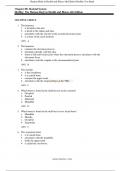
Chapter 08: Skeletal System Herlihy: The Human Body in Health and Illness, 6th Edition
Chapter 08: Skeletal System Herlihy: The Human Body in Health and Illness, 6th Edition MULTIPLE CHOICE 1. The humerus a. is located in the arm. b. is distal to the radius and ulna. c. articulates with the clavicle at the acromioclavicular joint. d. is a bone of the axial skeleton. ANS: A 2. The humerus a. contains the olecranon process. b. articulates distally with the ulna. c. forms a ball-and-socket joint where the olecranon process articulates with the olecranon fossa. d. articu...
- Exam (elaborations)
- • 16 pages •
Chapter 08: Skeletal System Herlihy: The Human Body in Health and Illness, 6th Edition MULTIPLE CHOICE 1. The humerus a. is located in the arm. b. is distal to the radius and ulna. c. articulates with the clavicle at the acromioclavicular joint. d. is a bone of the axial skeleton. ANS: A 2. The humerus a. contains the olecranon process. b. articulates distally with the ulna. c. forms a ball-and-socket joint where the olecranon process articulates with the olecranon fossa. d. articu...
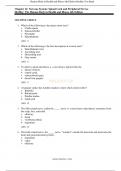
Chapter 11: Nervous System: Spinal Cord and Peripheral Nerves Herlihy: The Human Body in Health and Illness, 6th Edition
Chapter 11: Nervous System: Spinal Cord and Peripheral Nerves Herlihy: The Human Body in Health and Illness, 6th Edition MULTIPLE CHOICE 1. Which of the following is the major motor tract? a. Cauda equina b. Spinocerebellar c. Pyramidal d. Spinothalamic ANS: C 2. Which of the following is the best description of a motor tract? a. Spinothalamic tract b. Ascending tract c. Descending tract d. Gray matter ANS: C 3. To achieve spinal anesthesia, a -caine drug is injected into the a. ...
- Exam (elaborations)
- • 12 pages •
Chapter 11: Nervous System: Spinal Cord and Peripheral Nerves Herlihy: The Human Body in Health and Illness, 6th Edition MULTIPLE CHOICE 1. Which of the following is the major motor tract? a. Cauda equina b. Spinocerebellar c. Pyramidal d. Spinothalamic ANS: C 2. Which of the following is the best description of a motor tract? a. Spinothalamic tract b. Ascending tract c. Descending tract d. Gray matter ANS: C 3. To achieve spinal anesthesia, a -caine drug is injected into the a. ...

Chapter 12: Autonomic Nervous System Herlihy: The Human Body in Health and Illness, 6th Edition
Chapter 12: Autonomic Nervous System Herlihy: The Human Body in Health and Illness, 6th Edition MULTIPLE CHOICE 1. Which of the following is most related to the “feed-and-breed” system? a. Pyramidal tracts b. Sympathetic nervous system c. Craniosacral outflow d. Rapid heart rate, palpitations, sweating ANS: C 2. Which of the following is most characteristic of the parasympathetic nervous system? a. Adrenergic b. Norepinephrine c. Fight-or-flight response d. Feed-and-breed system...
- Exam (elaborations)
- • 7 pages •
Chapter 12: Autonomic Nervous System Herlihy: The Human Body in Health and Illness, 6th Edition MULTIPLE CHOICE 1. Which of the following is most related to the “feed-and-breed” system? a. Pyramidal tracts b. Sympathetic nervous system c. Craniosacral outflow d. Rapid heart rate, palpitations, sweating ANS: C 2. Which of the following is most characteristic of the parasympathetic nervous system? a. Adrenergic b. Norepinephrine c. Fight-or-flight response d. Feed-and-breed system...
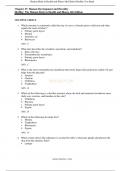
Chapter 27: Human Development and Heredity Herlihy: The Human Body in Health and Illness, 6th Edition
Chapter 27: Human Development and Heredity Herlihy: The Human Body in Health and Illness, 6th Edition MULTIPLE CHOICE 1. Which structure is commonly called the bag of waters (it breaks prior to delivery and often signals the onset of labor)? a. Primary germ layers b. Morula c. Amniotic sac d. Blastocyst ANS: C 2. What term describes the ectoderm, mesoderm, and endoderm? a. Inner cell mass b. Extraembryonic membranes c. Primary germ layers d. Blastomeres ANS: C 3. What is the oute...
- Exam (elaborations)
- • 10 pages •
Chapter 27: Human Development and Heredity Herlihy: The Human Body in Health and Illness, 6th Edition MULTIPLE CHOICE 1. Which structure is commonly called the bag of waters (it breaks prior to delivery and often signals the onset of labor)? a. Primary germ layers b. Morula c. Amniotic sac d. Blastocyst ANS: C 2. What term describes the ectoderm, mesoderm, and endoderm? a. Inner cell mass b. Extraembryonic membranes c. Primary germ layers d. Blastomeres ANS: C 3. What is the oute...
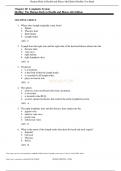
Chapter 20: Lymphatic System Herlihy: The Human Body in Health and Illness, 6th Edition
Chapter 20: Lymphatic System Herlihy: The Human Body in Health and Illness, 6th Edition MULTIPLE CHOICE 1. Where does lymph originally come from? a. Spleen b. Thoracic duct c. Interstitium d. Lymph nodes ANS: C 2. Lymph from the right arm and the right side of the head and thorax drains into the a. thoracic duct. b. vena cava. c. right atrium. d. right lymphatic duct. ANS: D 3. Thymosin a. is a hormone. b. is the fluid within the lymph nodes. c. is secreted by all lymph nodes. ...
- Exam (elaborations)
- • 6 pages •
Chapter 20: Lymphatic System Herlihy: The Human Body in Health and Illness, 6th Edition MULTIPLE CHOICE 1. Where does lymph originally come from? a. Spleen b. Thoracic duct c. Interstitium d. Lymph nodes ANS: C 2. Lymph from the right arm and the right side of the head and thorax drains into the a. thoracic duct. b. vena cava. c. right atrium. d. right lymphatic duct. ANS: D 3. Thymosin a. is a hormone. b. is the fluid within the lymph nodes. c. is secreted by all lymph nodes. ...
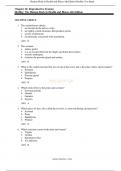
Chapter 26: Reproductive Systems Herlihy: The Human Body in Health and Illness, 6th Edition
Chapter 26: Reproductive Systems Herlihy: The Human Body in Health and Illness, 6th Edition MULTIPLE CHOICE 1. The seminiferous tubules a. are located in the pelvic cavity. b. are tightly coiled structures that produce sperm. c. secrete testosterone. d. are primarily concerned with ejaculation. ANS: B 2. The scrotum a. makes sperm. b. is a sac located between the thighs and holds the testicles. c. secretes androgens. d. contains the prostate gland and urethra. ANS: B 3. What is th...
- Exam (elaborations)
- • 14 pages •
Chapter 26: Reproductive Systems Herlihy: The Human Body in Health and Illness, 6th Edition MULTIPLE CHOICE 1. The seminiferous tubules a. are located in the pelvic cavity. b. are tightly coiled structures that produce sperm. c. secrete testosterone. d. are primarily concerned with ejaculation. ANS: B 2. The scrotum a. makes sperm. b. is a sac located between the thighs and holds the testicles. c. secretes androgens. d. contains the prostate gland and urethra. ANS: B 3. What is th...
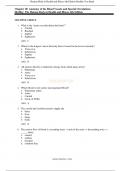
Chapter 18: Anatomy of the Blood Vessels and Special Circulations Herlihy: The Human Body in Health and Illness, 6th Edition
Chapter 18: Anatomy of the Blood Vessels and Special Circulations Herlihy: The Human Body in Health and Illness, 6th Edition MULTIPLE CHOICE 1. What is the “main vein that drains the brain”? a. Carotid b. Brachial c. Jugular d. Saphenous ANS: C 2. Which is the longest vein in the body that is located in the lower extremity? a. Vena cava b. Subclavian c. Jugular d. Saphenous ANS: D 3. All arteries directly or indirectly emerge from which large artery? a. Pulmonary b. Aorta c...
- Exam (elaborations)
- • 17 pages •
Chapter 18: Anatomy of the Blood Vessels and Special Circulations Herlihy: The Human Body in Health and Illness, 6th Edition MULTIPLE CHOICE 1. What is the “main vein that drains the brain”? a. Carotid b. Brachial c. Jugular d. Saphenous ANS: C 2. Which is the longest vein in the body that is located in the lower extremity? a. Vena cava b. Subclavian c. Jugular d. Saphenous ANS: D 3. All arteries directly or indirectly emerge from which large artery? a. Pulmonary b. Aorta c...

Bible Study Project Observation Template(2)(1) (complete Updated spring 2022-2023)
Midterm Exam 213 NURS 213 updated 2022/2023